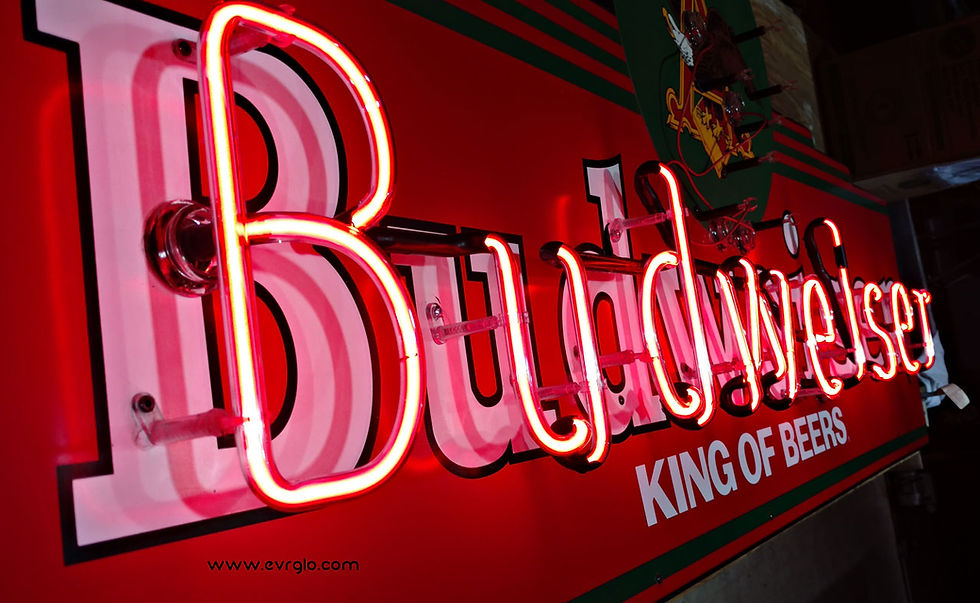Budweiser Neon Sign Restoration
- Neon Sign Shop

- Nov 18, 2016
- 3 min read
Updated: May 27, 2024

Restoration of a 1994 Budweiser King of Beers Neon Sign. Measured 60 inches wide by 28 inches tall by 7 inches deep.

When the sign was dropped off at the shop the sign was very dirty and both lettering tubes were broken and the eagle and circle tubes were missing.

We cleaned the sign, created new patterns for the replacement neon tubes and replaced several broken neon tube supports.

Replacement tubes were made for Budweiser in 12mm clear red neon.

Replacement neon tubes were made for the eagle and circle using 10mm green and 8mm clear red, white and yellow neon tubing.

Completed neon sign - This sign was very bright and was difficult to photograph.
Item code: 052016 CCO
All product names, logos, and brands are property of their respective owners. All company, product and service names used in this website are for identification purposes only. Use of these names, logos, and brands does not imply endorsement.
History of Budweiser Beer
Origins and Early Years
Budweiser beer, one of the most iconic and widely recognized beers in the world, has its roots in the mid-19th century. The story begins with Adolphus Busch, a German immigrant who came to the United States in 1857. Busch married Lilly Anheuser, the daughter of Eberhard Anheuser, who owned a small brewery in St. Louis, Missouri. Adolphus joined his father-in-law's business, which was then called E. Anheuser & Co.
In 1876, Adolphus Busch and his friend Carl Conrad developed a new lager beer inspired by the beers from the Bohemian region of what is now the Czech Republic, particularly the town of České Budějovice (known as Budweis in German). The beer was named Budweiser, meaning "from Budweis." This beer was brewed with a combination of Saaz hops, rice, and barley malt, giving it a distinctive, crisp flavor.
Expansion and Innovation
Budweiser quickly became popular due to its quality and consistency, which were enhanced by Adolphus Busch's innovative use of pasteurization to extend the beer's shelf life, allowing it to be shipped over long distances. Busch also pioneered the use of refrigerated railcars and artificial refrigeration in the brewing process, further ensuring the beer's quality during transport.
By the 1880s, Anheuser-Busch had grown into one of the largest breweries in the United States. The company continued to expand its operations, opening new facilities and adopting new technologies. The iconic Budweiser Clydesdales were introduced in 1933 to celebrate the repeal of Prohibition, becoming a symbol of the brand.
Marketing and Global Reach
Budweiser's success was bolstered by extensive marketing campaigns. The brand became known for its memorable slogans, such as "The King of Beers," and for its sponsorship of major sports events, including the Super Bowl and Major League Baseball. These marketing efforts helped Budweiser become ingrained in American culture.
In the late 20th and early 21st centuries, Budweiser expanded its global presence, entering markets around the world. The brand's reach was further extended through strategic acquisitions and partnerships, including the 2008 merger between Anheuser-Busch and InBev, creating Anheuser-Busch InBev, the largest brewing company in the world.
Contemporary Developments
In recent years, Budweiser has faced challenges from the growing craft beer movement and changing consumer preferences. To address these trends, Anheuser-Busch InBev has diversified its product line, introducing new variations of Budweiser such as Budweiser Select, Budweiser Black Crown, and Bud Light, which has become a best-seller in its own right.
The company has also focused on sustainability initiatives, aiming to reduce its environmental footprint through efforts like using renewable energy and sustainable packaging. Despite the competition and evolving market landscape, Budweiser remains a prominent and influential brand in the global beer industry.
Cultural Impact
Budweiser has left a lasting mark on popular culture, from its classic "Whassup?" commercials to its presence in movies and television shows. The brand's commitment to maintaining its heritage while adapting to contemporary tastes has helped it stay relevant over the years.
Conclusion
From its humble beginnings in 19th-century St. Louis to its status as a global icon, Budweiser's history is a testament to innovation, strategic marketing, and an unwavering commitment to quality. As one of the most recognizable names in the beer industry, Budweiser continues to be a significant player on the world stage, balancing tradition with modernity.




Comments